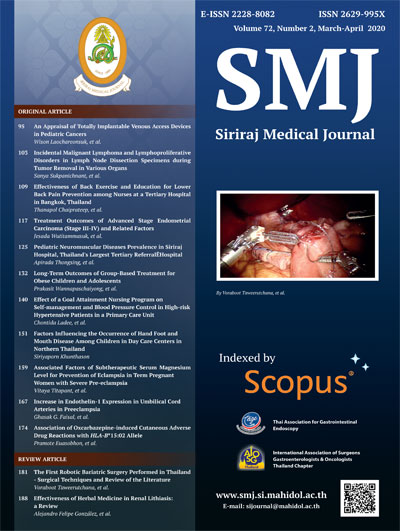Pediatric Neuromuscular Diseases Prevalence in Siriraj Hospital, Thailand's Largest Tertiary Referral Hospital
DOI:
https://doi.org/10.33192/Smj.2020.17Keywords:
Neuromuscular diseases; neurology; Duchenne Muscular Dystrophy; spinal muscular atrophyAbstract
Objective: There are no epidemiological data on childhood neuromuscular diseases in Thailand. We aimed to estimate the proportion of NMDs among pediatric neurology patients in Siriraj Hospital and determine the specific diagnosis.
Methods: A retrospective study was conducted in the pediatric neuromuscular clinic at Siriraj Hospital between 2014 and 2016.
Results: Of 1,994 patients aged < 21 years with neurological diseases, 217 (10.88 %) had received a diagnosis. Diagnostic clarity can be achieved using clinical tools such as electromyography, serum creatinine kinase, muscle histo-immunology, and genetic analysis. Of the 217 patients, 143 (65.9 %) had inherited and 74 (34.1%) had acquired neuromuscular diseases. The most common inherited NMD were the Dystrophinopathies, including Duchenne / Becker muscular dystrophy (n = 58), while spinal muscular atrophy was the second most common (n = 25). Myasthenia Gravis was the most common acquired neuromuscular disease (n = 36).
Conclusion: We found 10.88 percent of patients with neurological diseases have NMD. NMD is a chronic disease with poor quality of life and so multidisciplinary clinical care is crucial for these patients. In order to improve the standard of care, collaboration with government and other tertiary hospitals is important and will help serve a growing population of NMD patients.
References
2. Emery AEH. Population frequencies of inherited neuromuscular diseases—A world survey. Neuromuscul Disord 1991;1:19-29.
3. Deenen JC, Horlings CG, Verschuuren JJ, Verbeek AL, van Engelen BG. The Epidemiology of Neuromuscular Disorders: A Comprehensive Overview of the Literature. J Neuromuscul Dis 2015;2:73-85.
4. Hughes MI, Hicks EM, Nevin NC, Patterson VH. The prevalence of inherited neuromuscular disease in Northern Ireland. Neuromuscul Disord 1996;6:69-73.
5. Darin N, Tulinius M. Neuromuscular disorders in childhood: a descriptive epidemiological study from western Sweden. Neuromuscul Disord 2000;10:1-9.
6. Chung B, Wong V, Ip P. Prevalence of neuromuscular diseases in Chinese children: a study in southern China. J Child Neurol 2003;18:217-9.
7. Khedr EM, Fawi G, Abbas MA, Abo El-Fetoh N, Zaki AF, Gamea A, et al. Prevalence of neuromuscular disorders in Qena governorate/Egypt: population-based survey. Neurol Res 2016;38:1056-63.
8. Norwood FL, Harling C, Chinnery PF, Eagle M, Bushby K, Straub V. Prevalence of genetic muscle disease in Northern England: in-depth analysis of a muscle clinic population. Brain 2009;132:3175-86.
9. Emery AE. Population frequencies of inherited neuromuscular diseases--a world survey. Neuromuscul Disord: NMD 1991;1:19-29.
10. Lagergren J. Children with motor handicaps. Epidemiological, medical and socio-paediatric aspects of motor handicapped children in a Swedish county. Acta Paediatr Scand Suppl 1981;289:1-71.
11. World Federation of Neurology Research Committee Research Group on Neuromuscular Diseases. J Neurol Sci 1988;86:333-60.
12. Emery AEH. Diagnostic Criteria for Neuromuscular Disorders: Royal Society of Medicine Press; 1997.
13. Kuntzer T, Lettry-Trouillat R, Bogousslavsky J. Epidemiology of adult neuromuscular disorders. Rev Med Suisse Romande 2000;120:725-31.
14. Darras BT. Spinal muscular atrophies. Pediatr Clin North Am 2015;62:743-66.
15. Arnold WD, Kassar D, Kissel JT. Spinal Muscular Atrophy: Diagnosis and Management in a New Therapeutic Era. Muscle Nerve 2015;51:157-67.
Downloads
Published
How to Cite
Issue
Section
License
Authors who publish with this journal agree to the following conditions:
Copyright Transfer
In submitting a manuscript, the authors acknowledge that the work will become the copyrighted property of Siriraj Medical Journal upon publication.
License
Articles are licensed under a Creative Commons Attribution-NonCommercial-NoDerivatives 4.0 International License (CC BY-NC-ND 4.0). This license allows for the sharing of the work for non-commercial purposes with proper attribution to the authors and the journal. However, it does not permit modifications or the creation of derivative works.
Sharing and Access
Authors are encouraged to share their article on their personal or institutional websites and through other non-commercial platforms. Doing so can increase readership and citations.















